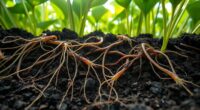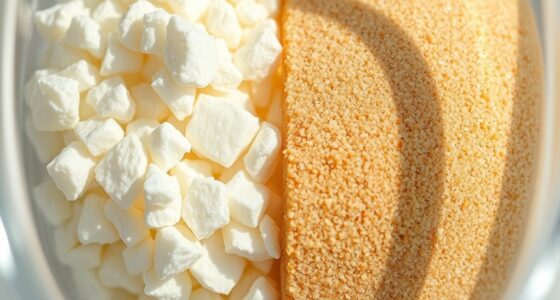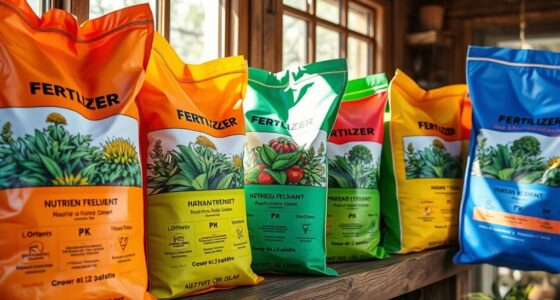Understanding N-P-K ratios helps guarantee your plants get the right nutrients for healthy growth. Nitrogen (N) promotes lush foliage, phosphorus (P) supports roots and flowering, while potassium (K) boosts overall vigor and disease resistance. Choosing a fertilizer with the proper balance depends on your plant’s specific needs. Knowing these basics can make a big difference. Keep exploring to learn how to match fertilizers perfectly to your garden’s requirements and keep your plants thriving.
Key Takeaways
- N-P-K stands for nitrogen, phosphorus, and potassium, the primary nutrients plants require for healthy growth.
- Different plants have specific N-P-K ratio needs depending on their growth stage and type.
- Nitrogen promotes leafy, green growth; phosphorus supports roots and flowering; potassium enhances overall plant vigor.
- Proper balance and application of N-P-K prevent deficiencies and reduce environmental impact.
- Combining organic and synthetic fertilizers can optimize nutrient availability and support sustainable plant health.

Have you ever wondered how plants thrive and produce bountiful yields? The secret lies in understanding the essential nutrients they need and how to provide them effectively. One of the first things to consider is soil pH, which plays a crucial role in nutrient absorption. If your soil is too acidic or alkaline, your plants might struggle to access vital nutrients, even if you’re applying fertilizer. For example, a soil pH below 6.0 can limit the availability of nitrogen, phosphorus, and potassium, the primary nutrients plants rely on. Testing your soil’s pH helps you determine if adjustments are necessary before adding fertilizers. You might need to amend your soil with lime to raise pH or sulfur to lower it, depending on your plant’s needs. Understanding soil pH is essential because it influences how well plants can utilize the nutrients you provide.
When it comes to choosing fertilizers, you’ll notice a significant difference between organic and synthetic options. Organic fertilizers, like compost, manure, or bone meal, release nutrients slowly and improve soil health over time. They boost microbial activity, which helps plants absorb nutrients more efficiently. On the other hand, synthetic fertilizers are manufactured chemical blends designed to deliver specific nutrients quickly. They’re often more concentrated and can give rapid results, but they don’t improve soil structure or microbial life as effectively as organic options do. Your choice depends on your gardening goals, time frame, and environmental considerations. Many gardeners opt for a balanced approach, combining organic matter with targeted synthetic feeds to optimize plant health.
Organic fertilizers release nutrients slowly and boost soil health, while synthetic options provide quick, concentrated nutrient delivery.
Understanding the N-P-K ratio on fertilizer packaging is vital. N-P-K stands for nitrogen, phosphorus, and potassium, the three primary nutrients plants need. Nitrogen promotes lush, green foliage; phosphorus encourages strong roots and flowering; potassium supports overall plant vigor and disease resistance. Different plants have varying requirements, so selecting a fertilizer with the right ratio can make all the difference. For example, leafy greens benefit from higher nitrogen, while flowering plants thrive with more phosphorus. Always follow the recommended application rates to avoid over-fertilizing, which can harm plants and the environment.
In essence, nurturing healthy plants involves more than just sprinkling fertilizer. It requires understanding your soil’s pH, choosing the right type—organic versus synthetic—and tailoring nutrient ratios to your specific plants. When you pay attention to these factors, you give your plants the best chance to grow strong, produce abundant yields, and remain resilient against pests and diseases. Fertilizer isn’t just about feeding your plants; it’s about creating an environment where they can flourish sustainably and healthily.
Frequently Asked Questions
How Often Should I Fertilize Indoor Plants?
You should fertilize indoor plants every 4 to 6 weeks, depending on their growth stage. Keep in mind, watering frequency impacts nutrient absorption, so don’t overwater. Also, check soil pH—most indoor plants thrive in slightly acidic to neutral soil. Adjust your fertilizing schedule if you notice signs of nutrient deficiencies or overfeeding. Regularly monitoring these factors helps your plants stay healthy and vibrant.
Can I Combine Different Fertilizers Safely?
Think of fertilizer compatibility like a well-rehearsed orchestra—when ingredients harmonize, your plants thrive. You can safely mix fertilizers if they’re compatible; check labels and avoid combining different chemical types that might react negatively. Always read instructions carefully and test small amounts first. Mixing fertilizers carefully guarantees your plants get balanced nutrients without stress, turning your indoor garden into a lush symphony of growth.
Are Organic Fertilizers Better Than Synthetic Ones?
When comparing organic vs synthetic fertilizers, it depends on your priorities. Organic fertilizers often have a lower environmental impact, helping protect soil health and reduce chemical runoff. Synthetic options can provide quick nutrient boosts but may harm the environment over time. You should consider your garden’s needs, how sustainable you want your practices to be, and the long-term effects on soil and plant health when choosing.
How Do I Know if My Soil Needs Fertilizing?
You can tell if your soil needs fertilizing by starting with soil testing, which reveals nutrient deficiencies. If tests show low levels of key nutrients like nitrogen, phosphorus, or potassium, it’s time to fertilize. Look for signs like yellowing leaves, stunted growth, or poor flowering, which also indicate nutrient shortages. Regular testing and observation help you provide the right nutrients, ensuring your plants stay healthy and thrive.
What Are Signs of Fertilizer Overuse or Deficiency?
You might notice plant toxicity signs like browning leaf edges, stunted growth, or wilting if you over-fertilize. Conversely, nutrient deficiency symptoms include yellowing leaves, poor flowering, or weak stems. Both overuse and deficiency disrupt plant health, so monitor your plants closely. Proper fertilizing balances nutrients, preventing toxicity and deficiencies, ensuring your plants thrive. Regularly check for these signs to adjust your fertilization habits accordingly.
Conclusion
Now that you understand the basics of N-P-K and what your plants need, you’re better equipped to choose the right fertilizer. Remember, healthy plants thrive with the right balance of nutrients tailored to their growth stage. Are you ready to give your garden the boost it deserves? With a little knowledge and care, you’ll enjoy lush, vibrant plants that flourish season after season. Your garden’s best days are just a fertilizing session away!









